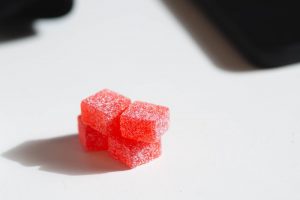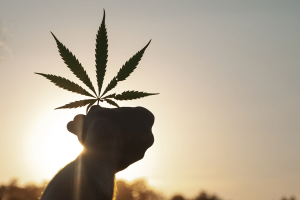Is Hemp CBD The Same As Cannabis CBD?
The quick answer is “No, they are NOT the same”.
Even though they are different, the terms “hemp” and “cannabis” are often incorrectly used interchangeably. In this blog post, we will explore why this is the case. First, let’s look at the bigger picture to learn more about where these plants belong in the wonderful world of flora and plants.
The Hemp and Cannabis “Family Tree”
A Lesson in Taxonomy
Taxonomy is the science of naming, describing, and classifying organisms to include all plants, animals, and microorganisms of the world. In the 1700s, botanist Carl Linnaeus established the basic framework by which we connect how all life on earth is related…from Kingdom, Phylum, Class, Order, Family, Genus and lastly, Species.
It’s easiest to see these connections using a chart. Working from the top down, we can see that Cannabis is a plant, and part of the “Plantae” Kingdom. It is further classified as part of the “Rosales” Order, making roses a distant relative! Moving down the family tree, we identify “Cannabis ruderalis,” “Cannabis sativa” and “Cannabis indica” all subspecies of the “Cannabis” species.

The Three Main Subspecies: Ruderalis, Sativa and Indica
Let’s next focus on what makes these three subspecies unique:
Cannabis Indica: First identified in the Indian subcontinent, this plant is characterized by a bushy appearance. Fan leaves are shorter, flowers are denser, and the plant is more compact overall. Indica plants often present a higher THC content than sativa counterparts, with impairing effects that are described as being felt more “within the body.”
Cannabis Sativa: Indigenous to Western Asia, the cannabis sativa plant is taller and lankier, with flowers that are not as dense as indica flowers. Cannabis sativa plants also contain THC, as well as many other cannabinoids, including CBD. The psychoactive effects from cannabis sativa are often described as “more cerebral.”
Cannabis Ruderalis: Is a wild growing, smaller plant native to Russia and central Europe, and can be high in CBD. Ruderalis plants flower very quickly and tend to be hardy, which is why they are often crossbred with cannabis indica and sativa plants to produce strong, fast flowering hybrids.
In fact, years of cross breeding indica, sativa and ruderalis have blurred the lines of these subspecies. Some say that all modern cannabis plants these days are “hybrids” with varying degrees of differing properties. It is interesting to note that CBD rich plants are more likely to have stronger ruderalis genetics than high-THC plants.
So… What is Hemp?
After reviewing the Cannabis “family tree”, it’s actually…quite simple! Hemp is defined as any plant in the “Cannabis” species that contains less than 0.3% tetrahydrocannabinol, or THC. The extremely low level of THC is the key differentiating factor, and why consuming hemp does not produce intoxication or the feeling of being “high.” Hemp has been cultivated throughout the ages as a valuable source of seeds, food, oil, and textiles. In more recent years, hemp has been aggressively produced for CBD products.
All other cannabis plants with more than 0.3% THC are therefore not hemp and are referred to as marijuana, or a variety of other names including: cannabis, weed, ganja, Mary Jane, grass, etc. Because these plants contain more THC, consumption may result in intoxication, but also increased medical benefits such as appetite stimulation and sedation for sleep.
It’s fascinating to note that to the naked eye and without a lab test, it can be difficult to tell the difference between a hemp plant and a higher THC cannabis plant. But on the inside, due to the difference in cannabinoid content and naturally occurring THC levels, they are quite different and best described as distinct and separate cousins.
The Difference between Hemp CBD and Cannabis CBD Products
There IS a difference, and it comes down to “The Entourage Effect”, the synergistic relationship between cannabinoids such as CBD and THC, terpenes, and flavonoids working together to produce a positive therapeutic outcome.
Hemp CBD products are derived from hemp plants containing less than 0.3% THC. The appeal of hemp CBD products is that they contain virtually no THC. This is also precisely the reason that those products may have limited efficacy, especially when trying to treat symptoms of a medical condition. Although hemp CBD products may work to an extent, they lack enough THC to unlock the potential of benefits from the entourage effect.
CBD-rich products that are derived from non-hemp plants with more than 0.3% THC is enough to “kick start” the entourage effect. The good news for those seeking the benefits of the entourage effect but wish to avoid impairment is that CBD products containing less than 3% THC are still considered to be non-impairing. This means that non-hemp, low THC, high CBD products offer the best of both worlds: Reduced likelihood of impairment with increased entourage effect potential and efficacy. CBD is also shown to modulate or “dampen” the effects of THC and helps limit feelings of impairment.
Safety and Regulation: A Stronger Case For Cannabis Derived CBD Products
We’ve covered the plants themselves and why they are different, but there’s more! The other side of the story entails every step of a plant’s journey from seed to harvest to sale. Production processes and safety regulations should all be considered when assessing hemp and non-hemp cannabis products. Hemp is much less regulated, especially in the United States. In Canada, licensed producers must comply with Health Canada’s rigorous guidelines to be able to grow and sell cannabis products to medical patients and cannabis consumers. It is safe to say that hemp or marijuana CBD products bought from Canadian licensed producers are the most reliable and safer for medical patients to consume.
For a deep dive into the benefits of being a medical patient (versus buying recreationally) please check out our previous blog post.
Making Your Choice: Hemp or Cannabis? We Can Help!
Hemp CBD products are now readily available everywhere. However, if you have tried Hemp CBD in the past and found that it was not as effective as you had hoped, the distinctions between hemp and non-hemp derived CBD mentioned above may point to why. Medical cannabis, with its potent entourage effect for optimal benefit may offer a solution to managing your symptoms.
Want to keep learning about cannabis and its benefits? Browse our collection of clinical summaries for patients. Conditions include anxiety, arthritis, chronic pain, migraines, multiple sclerosis, opioid reduction and topicals.
Or are you ready to get started on your medical cannabis journey? Harvest Medicine is here to provide trusted, evidence-based, reliable medical guidance and ongoing support. Book your no-cost appointment and come chat with one of our friendly doctors, nurse practitioners and patient educators to help you determine what is best for you.
References:
National Center for Biotechnology Information. (n.d.) Cannabis Sativa. https://www.ncbi.nlm.nih.gov/Taxonomy/Browser/wwwtax.cgi?mode=Info&id=3483
Escondido, N. (n.d.) Cannabis Taxonomy & Nomenclature. Cannabis Genetics Institute. https://cannabisgeneticsinstitute.com/cannabis-taxonomy-and-terminology/
Wholyme. (2020-10-26). Understanding the Cannabis Plant: Welcome to the Cannabaceae Family. https://wholyme.com/blogs/wellness-routine/welcome-to-the-cannabaceae-family/
Sensiseeds. (2020-10-07). The Cannabaceae and Phylogenetics. https://sensiseeds.com/en/blog/the-cannabis-family-tree-cannabaceae-and-phylogenetics/
Hillig, K.W., Mahlberg, P. G., (2004-01-06). A chemotaxonomic analysis of cannabinoid variation in Cannabis (Cannabaceae). American Journal of Botany. https://bsapubs.onlinelibrary.wiley.com/doi/10.3732/ajb.91.6.966







